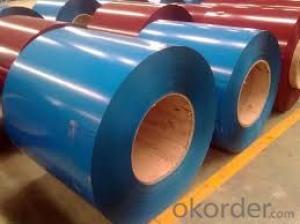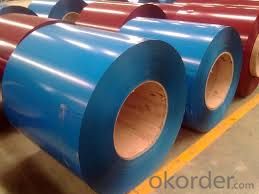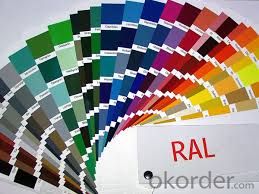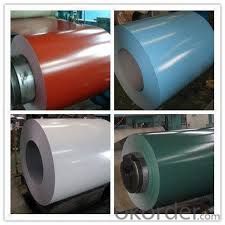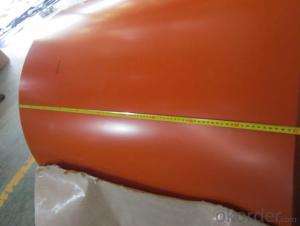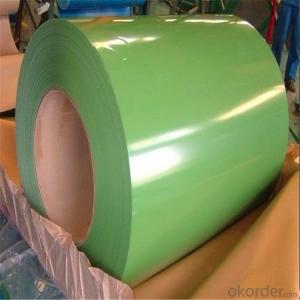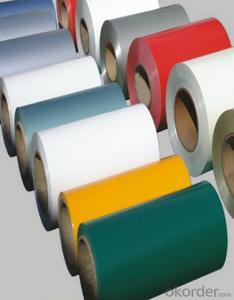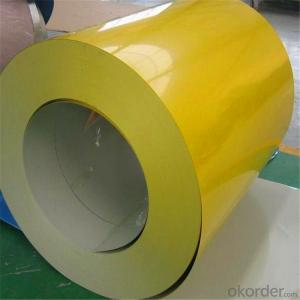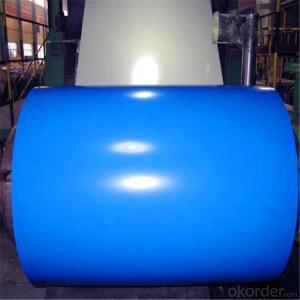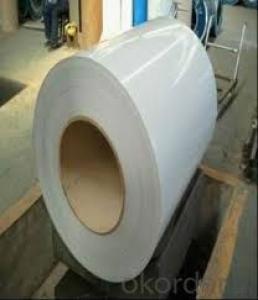Pre-Painted Color Coated Galvanized Steel Coil/PPGI
- Loading Port:
- China main port
- Payment Terms:
- TT OR LC
- Min Order Qty:
- 25 m.t.
- Supply Capability:
- 1000 m.t./month
OKorder Service Pledge
OKorder Financial Service
You Might Also Like
Product Description
PPGI and PPGL
0.14-3.0mm Special Color Galvanized / galvalume Steel Coil
1. Techinical standard: EN10169
2. Grade: TDX51D, SGCC
3. Thickness: 0.14-3.0mm (the most advantage thickness)
4. Width: 600-1250mm (610/724/820/914/1000/1200/1219/1220/1250)
5. Base metal: Galvanized / galvalume steel
6. Finish Painting: 15-20miu PE on top
Back painting: 5-8miu PE on back
7. Type of PPGI and PPGL with pattern
Specifications:
1. Standard: AISI, ASTM, BS, DIN, GB, JIS, ASTM, JIS, GB
2. Steel Grade: DX51D, SGCC, SGCH, SPCC, SPCD, DC01, ST12, ST13, Q195, 08AL
3. Thickness: 0.14-3.0mm
4. Width: 600-1250mm
5. Length: Up to The Thickness or as require
6. Spangle: Zero, Mini, Regular, Big, Skin Pass
7. Audited Certificates: BV, SGS, ISO, CIQ
8. Zinc Coating: 40g-275g or AZ 40-150g
9. Surface: Chromated, dry/oiled, Cr3 treated anti-finger
10. Package: Standard exporting package (or as required)
Why Us:
1, Mill/factory supply, Quality protection, 4 Galvanized steel lines keep runing.
2, Competitive price with best quality and service
3, Nearest sea port, Convenient transportation, Efficient service team online for 24 hours
4, More than 7 years Export Experiences, More than 50 countries customers
5. Delivery time: Within 25-35 days after the receipt of L/C or according to customer's requirement.
Warranty:
As the professional manufacturer and supplier of the steel, CNBM steel corporation makes the steel co-operation mutual beneficial without any risky to the worldwide customers. CNBM Steel sales&service department not only promise to provide the high quality products, excellent communication, fast and reliable deliveries, as well as the reasonble price, but also help the customers to develop the market better with more efforts.
World wide customer satisfaction:
More than 50 worldwide customers none-risky experiences approved.
CNBM Steel has been exporting steel coils to more than 50 countries directly. Our long term supply extends to USA, UK, Germany, Italy, Spain, Belgium, France, Poland, Greece, Ukraine, Belarus, Russia, Turkey, Egypt, Saudi Arabia, Iran, Ethiopia, Niger, Brazil, Colombia, Chile, Peru, Australia, New Zealand, etc...
commodityColor-coated Roofing Galvanized Steel sheet
Techinical Standard: JIS G3302-1998, EN10142/10137, EN 10169
gradeSGCC, DX51D / DX52D / S250, 280GD
Types: For general / drawing use
Thickness0.14-3.0mm
Zinc Coating: 40g-275g or AZ 40-150g
Spanglet:No/ small/ big regular
Surface treament:Chromed passivation, anti-finger print, skinpassed
Sheet weight:3-5MT
Profile model: YX14-65-825/ YX18-76.2-836 / YX14-63.5-825 /
YX35-125-750 / YX15-225-900 / YX10-125-875 /
YX12-110-880 / YX25-210-840 / YX25-205-820(1025)
Package: Properly packed for ocean freight exportation in 20' ' containers
Application:Roof, walls, internal and external decorating materials, building etc
Price termsFOB, CFR, CIF
Payment terms20%TT in advance+80% TT or irrevocable 80%L/C at sight
delivery time25 days after recepit of 20% TT
RemarksInsurance is all risks
MTC 3.1 will be handed on with shipping documents
We accept SGS certificatation test
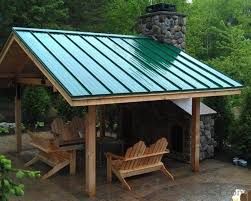
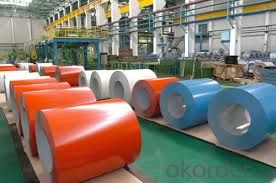
commodity | Brick pattern Color Galvanized Steel Sheet (PPGI/ PPGL) |
Techinical Standard: | JIS G3312-1998, EN101169, ASTM A755 |
grade | TSGCC, TDX51D / TDX52D / TS250, 280GD |
Types: | For general / drawing use |
Base metal | galvanized, galvalume |
Thickness | 0.14-3.0mm(0.16-0.8mm is the most advantage thickness) |
Width | 610/724/820/914/1000/1200/1219/1220/1250mm |
Type of coating: | PE, SMP, PVDF |
Zinc coating | Z60-275g/m2 or AZ40-150g/m2 |
Top painting: | 5 mic. Primer + 15 mc. R. M. P. |
Back painting: | 5-7 mic. EP |
Color: | According to RAL standard |
ID coil | 508mm / 610mm |
Coil weight: | 4--8MT |
Package: | Properly packed for ocean freight exportation in 20' ' containers |
Application: | Industrial panels, roofing and siding for painting / automobile |
Price terms | FOB, CFR, CIF |
Payment terms | 20%TT in advance+80% TT or irrevocable 80%L/C at sight |
delivery time | 25 days after recepit of 20% TT |
Remarks | Insurance is all risks |
MTC 3.1 will be handed on with shipping documents | |
We accept SGS certificatation test |
- Q: What is the difference between black steel pipes and galvanized steel pipes when used for water or gas, and why?
- Black Steel or ductile steel pipes are made from scrap for the most part. Galvanized pipes are made from new raw materials and are electroplated to resist rust.
- Q: I just bought some cheap earrings from this beauty supply store but they said surgical steel So will they prevent my ears from bleeding / infection ?
- Surgical steel is a grade of steel often used in medical appliances like tweezers, forceps, etc. It's generally non-reactive and considered very safe. It doesn't contain any special properties against infection--you still have to observe basic hygiene and clean your piercings properly--but most people can wear surgical steel earrings without a problem. However, if you have a contact allergy to base metals like nickel, surgical steel may cause redness or irritation because of the metals used in it. If cheap rings or necklaces make your skin break out in a rash you should NOT wear surgical steel.
- Q: So finally got around to watching man of steelnow i heard a few times that batman was in iti didn't se him.in the film is it something subtle I've just missed or is he not in it?when i googled it got loads of results for them being together in the new film but nothing about man of steel 2013
- No Batman will be in the next superman film think it's scheduled for next year
- Q: Can steel coils be customized?
- Yes, steel coils can be customized to meet specific requirements such as size, shape, thickness, and surface finish. Customization can be done through processes like cutting, slitting, shaping, and coating to ensure that the steel coils are tailored to the desired specifications.
- Q: I remember my dad saying something about steel toed boots but I forgot =#92; I went and checked out all the stores and got a pair with good ankle support but they also have steel toes. Would this interfere with the shifter or anything? I figure if anything my dirt bike shoes have the steel toes too. Any opinion?
- I personally like to feel the shifter, and I've found that I can't feel the shifter as well through steel toed boots. Steel toed boots are designed to protect you in the event of something heavy dropping on your foot - which isn't very likely on a motorcycle. I have also found that in extreme cold that steel toed boots seem to act like a heat sink for your feet - non steel toed boots seem to stay just a little bit warmer. If you're a new rider, a very blunt toe (whether steel or not) can make getting your toes under the shifter a little more difficult, but with some practice and experience, you will get used to it. Honestly, I don't think it really makes all that much difference. All new riders have difficulty with the shifter, and it will take time for you to get used to it either way. I don't think the difference is really even worth going out and buying another set of boots, but yeah, if you were getting your first pair, I would tell you to look for a boot with a toe that is slender and tapered (vs. blunt), and non-steel.
- Q: Can steel coils be coated with chemical-resistant materials?
- Yes, steel coils can be coated with chemical-resistant materials. These coatings are designed to protect the steel surface from the corrosive effects of chemicals or other harsh substances. The chemical-resistant coating forms a barrier that prevents the chemicals from directly interacting with the steel, enhancing its durability and longevity.
- Q: Alright...Please tell me what I can and can't buy for Steel Legion in detail(Much Detail please)Ogryns.Las canons.The problem I'm having is that they don't have steel Legion Uniform..does it matter?1.I also heard that you can't use Commisar Yarrick.(So what could I use?)2.What are my Hq choices,Fast attack,Heavy Support,Elite etc.3.Steel Legion has a Commisar....(Do I buy one for each squad of Steel Legion or one?)Please in detail what should I buy...I don't have the codex yet but will soon!!4.I also heard that if I get Steel Legion I need a transport for everything?(Is this true?)5.Please be detail on what i can't and can buy!!(Please like HQ Squad leader,Sargent)
- here are a couple of things about the steel legion. you should have a lot of mechanized units, have chimaras for rvery squad if posible, artillery fire helps a hell of a lot. also sentinals and leman russes and hell hounds also help. if in apocolypse, use banblades and titans. storm trooper squads should be your base squadrons. put them in chimeras and get near the action, drop 'em off and rapid fire like CRAZY!!! the steel legion loves heavy weapons so remember to get some heavy weapons platforms. there favourite weapons are grenade and missle launchers. there is also an officer you can buy with a power sword with the steel legion look. steel legion are big xeno hunters. because commisar is a ork killer you should be allowed to field him. ratling/ sniper squads also help and if you can get a vindicare assassin that is very useful.
- Q: How are steel coils used in the manufacturing of drivetrains?
- Steel coils are used in the manufacturing of drivetrains as they are commonly used to create various components such as gears, shafts, and bearings. These coils are typically processed and shaped into the required forms through cutting, molding, and heat treatment. The steel's strength and durability make it ideal for withstanding the high stresses and forces experienced in drivetrain systems, ensuring reliable and long-lasting performance.
- Q: So carbon is gas that brakes down to hydrogen and helium before going in...And steel can go a little farther towards sun before evaporating.. 200 degrees closer at leastso steel is full of a heavier gas bomb in my hypothesis and needs to be broken up outside stars(broken down)Is steel capable of going into sun with an element thats wrong wayLike iron has no air to boil outAnd steel goes just as far with carbon in it..Other words can u answer me with..Carbon is already IN the sun and is capable of braking down Carbon INSIDE the star/sunOnly way I see steel boiling is inside and it releases carbon gas at once..carbon bomb
- Carbon NEVER breaksdown into hydrogen and helium. Steel is an alloy of iron that contains carbon. Send either into the sun and they go from being a solid to a liquid to a gas to a plasma as the temperature increases on its approach but neither breaksdown into something else. Carbon as a solid or a plasma is still carbon and the same is true for iron. There are small amounts of most elements in the sun but it is mostly hydrogen.
- Q: How are steel coils used in the manufacturing of renewable energy equipment?
- Steel coils are used in the manufacturing of renewable energy equipment, such as wind turbines and solar panels, as they provide structural support and durability. The coils are typically used to create the framework or housing for these devices, ensuring their stability and protection against harsh environmental conditions. Additionally, steel coils are also utilized in the production of electrical components and wiring systems, which are essential for the generation and transmission of renewable energy.
Send your message to us
Pre-Painted Color Coated Galvanized Steel Coil/PPGI
- Loading Port:
- China main port
- Payment Terms:
- TT OR LC
- Min Order Qty:
- 25 m.t.
- Supply Capability:
- 1000 m.t./month
OKorder Service Pledge
OKorder Financial Service
Similar products
Hot products
Hot Searches
Related keywords
